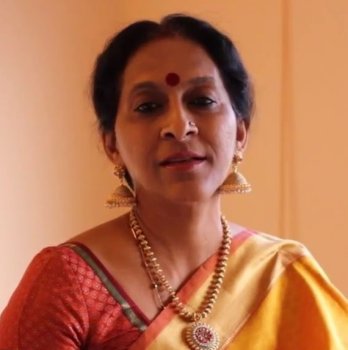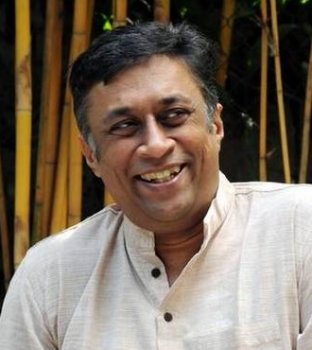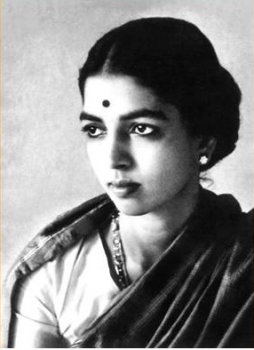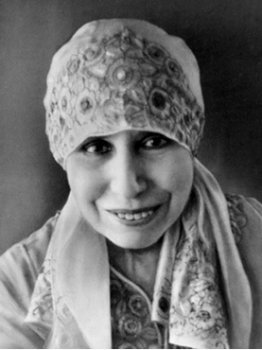
|   |

|   |
March 1, 2019  The old has collapsed But tries to stitch together its fallen pieces To weave another tapestry To give it a life span But staggers at every step, and falls apart again It tries to patch work - but now Even that doesn't work It has come to a halt! - Excerpted from the New Vision statement of AUROVILLE Let me open by saying that despite all the social media posts and discussions, reviews and blogs about performances, THIS monthly editorial seems to be more anticipated, quoted, excerpted, dissected, discussed, debated and shared. It is both a compliment and a marker for the changing styles of dance discourse. This once a month observations on performances and dance related events were always meant to be subjective. #A RASIKA'S DREAM  Bombay Jayashri  Sanjay Subrahmanyan The first few days in February saw me leaving the idyllic village of Manjakudi and returning home. The reason was the premiere of my large group production NAACHIYAR. What I did not mention was the fantastic festival of Carnatic musicians and dance artistes that the rural audiences were treated to. Now in its 14th year, trustee Sheela Balaji has transformed a sleepy village into an oasis of cleanliness, organic farming, education and cultural development. Away from the madness of the Chennai December season, I had the opportunity to listen to Sanjay Subrahmanyan, Bombay Jayashri, Savita Narasimhan and Ashwath Narayan. The disciplined audience of elders and students filled the lovely modern auditorium and sat in pin drop silence. No walking out during the RTP (Ragam, Tanam, Pallavi) sections, no cell phone browsing, no show offs by putting 'talam' loudly in the front seats. There was warm applause at the end of a Raga Alapana, appreciation after the percussion and violin solos - this was an audience of 'RASIKAS'! And fifty percent of the audience were school children! #THIEVES AND MARAUDERS The very next day after the Manjakudi premiere of NAACHIYAR, I was alerted by a dancer on social media that one of my performance images had been stolen and used as a PR tool for a nonexistent online magazine. On further probing the source, I located the 'culprit' in Bengaluru who had already appropriated images of other well-known artistes without their knowledge and proceeded to fleece gullible dancers with the promise of fame and performances! And these silly dancers actually believed him! What a scam artiste! An online petition to take down his Facebook page and the subsequent outrage at such blatant thuggery also exposed the desperation of dancers who are willing to do anything for a gig! Thank you to all those who gathered around me and helped solve this vexing problem. Putting a water mark on all our images takes time but I suppose it must be done to protect our hard work! #KATHAK, KOOTHU & NATURE
MERAKI, a Greek word for 'doing something with soul, creativity, or love', featured Kumiben's favourite dancer Sanjukta Sinha in the lead. A dance narrative about a girl searching for love and happiness fell short of a convincing storyline but scored high on group choreography. The fantastic way in which Kumiben can achieve that great arch of the body as it bends backwards in an elegant curve is really fascinating. Her beautiful use of space has always been her hallmark and in MERAKI she did not disappoint. Despite the programming faux pas of starting at 8pm for a Chennai audience, the show attracted enough fans to fill the downstairs. What did not work for me was the weak storyline and the distracting dancing of Sanjukta. No matter what she does - and she is an international star with an assured stage presence and energy that sparkles - her style seems very unlike the rest of the ensemble. Sanjukta has a distracting stage presence that is focused on her own glamorous personality which did not fit with the rest of the cohesive ensemble. Overlong solos did little to move the story forward and I found myself waiting for her sections to end. MERAKI may well be Kumiben's last large group work since she is now almost 90 years old. Her contribution to Kathak and its modern facets is unmistakable and her global reputation is well earned. MERAKI is perhaps not her best work, but her enthusiasm and love for Kathak is palpable. #SWAYING TREES AND BODIES
#CHURNING WATERS
As the title itself suggests, the work invited Australian indigenous women, Therukoothu traditions and Bharatanatyam into the space of migration, colonisation, intercultural dialogue and appropriation. The ideas converged into the global menace of polluting the oceans and rivers. I watched the final performance of CHURNING WATERS in the sprawling campus of DAKSHINACHITRA outside Chennai. The space holds traditional architecture from many States and communities on South India and Priya Srinivasan (CHURNING WATERS project ideator and director) was obviously seduced by the smorgasbord of locations that were available to her. The use of indigenous rituals seemed natural in the open air space but the demands of the audience to walk to each venue with poor signage and guidance soon dampened many spirits. This was perhaps a nod to the Australian tradition of a WALKABOUT - where teenagers experience a rite of passage in the wilderness - but on that warm Sunday afternoon, it did not have many takers. Adding to that, the microphones failed miserably, making the important dialogues inaudible. Visually, CHURNING WATERS looked stunning in the parts where the large earth mothers walked naturally, waving their hands and thumping their chests. The Tamil speaking Therukoothu artiste was a delight in his abandon and poise when encountering a different language and culture. There was, in their interactions, a flow and generosity that did not require language. Somehow, the presence of Bharatanatyam dancer Priyadarsini Govind in her silk, gold, bells and full makeup jarred in the otherwise relaxed ambience. Priya Srinivasan's final image of being draped as a bride smothered in plastic and then 'raped' as a symbol of the planet could have been amplified for a better impact. In the current atmosphere of hostility about class, caste, forgetting, cultural genocide and appropriation, CHURNING WATERS seemed like an ongoing work in progress. The questions it threw up became knotted into the jerky narrative and a far too open-ended presentation. Audiences around me were part tourist, part rasika and most were disoriented about the intention of the collaboration. The previous performances in Kanchipuram and at the more compact venue of ADISHAKTI in Auroville had warmer responses and a positive media review. The off stage enrichment for the indigenous women who were travelling overseas for the very first time in their lives must have provided several priceless memories. As an artistic effort, CHURNING WATERS still has to connect the dots between idea and execution. I always believe that one has to understand the audience, the demographic and the cultural milieu of when, where and to whom we perform. Every performance needs to be tweaked and adjusted, especially those with multiple strands and layered ideas. #GURU SARASA REMEMBERED A woman of the hereditary community who was a successful teacher and choreographer was remembered and celebrated through 3 days of dance and talks. K J Sarasa "teacher" was a popular guru during her life in Madras/Chennai and her influence touched women across generations and classes. My aunts learned from her and spoke of her "joie de vivre" and elan! The festival, beautifully organized by her student-dancer Shanmugam, drew houseful crowds and many standing ovations. Lavanya Ananth once again impressed with her elegant and precise dancing as did Ramli Ibrahim (does he EVER stop?!) The surprise of the festival was actor Suhasini Maniratnam who was coached for 10 days by Shanmugam and who wore a traditional red costume with full make up and jewellery in the presence of her director husband who beamed in appreciation! Chitra Visweswaran delivered a soulful hour long presentation that showcased her maturity and experience with intelligence. S Janaki, the editor of SRUTI magazine returned to the stage after years and drew sustained applause. A separate review of her show appears on this site. Shanmugam deserves a special commendation for his relentless passion and respect for his departed guru. His genial manner has won him a large circle of friends and well wishers in the classical dance community of Chennai. #OLD IS GOLD? There is a perceptible growing interest towards vintage and hereditary repertoire pieces in Bharatanatyam. Putting aside the exhausting and never ending arguments about dance history and the changing fortunes of the Isai Vellalar communities in South India, students, mostly from overseas, are turning their attention to older dance compositions and gathering around senior scholars and performers who still have the memory and knowledge of the traditional repertoire in their bodies. Lakshmi Viswanathan has found a new lease of life as a speaker and teacher in her relaxed and very accessible style of Tanjavur Bharatanatyam. Professor Davesh Soneji's erudite presentation on KALAVANTULA WOMEN of Andhra was very well received. Yashoda Thakore's vintage performance was another reminder of the sensuous charm that we have almost totally lost in today's whirlwind dancing. What I found very watchable was young Aniruddha Knight responding to the one word LOTUS at a small gathering to honour his grandmother Balasaraswati. Curated and organised by Savita Narasimhan of MOPA (Museum of Performing Arts, Chennai), the beautiful exhibition (many images in ROVING EYE) brought Bala's personal collections on display for the very first time. In the midst of this memorabilia, Aniruddha danced confidently about the style that he has inherited from his mother and teacher Lakshmi Knight. Ani's 'HASTAS' on that one word - LOTUS- conjured more than 30 images of the bloom, each one different from the other. Preceding Aniruddha's short performance was his student ABHINAYA, who was a revelation. Relaxed and calm, this young girl performed the Alarippu with an apt Tiruppugazh underlay and followed it up with a beautiful Jatiswaram. Such poise and such presence! Aniruddha can be proud of her and the many years he has spent honing his music, dance and teaching skills. I cannot wait for ABHINAYA's arangetram later this year. #MAYA-MADHU KATHAK CELEBRATED For most South Indians, Kathak and the Hindustani music community seem like a planet away. The style, mannerisms and on stage behaviour is so different from the classical forms of the Deccan. Bharatanatyam in particular, prides itself on a large fraternity of educated and articulate practitioners. The recent radio silence from almost the entire Kathak community during the #METOO uproar was a case in point. It seemed like a conspiracy to shield the worst sexual offenders from any sort of blame! All veils, prejudices, misconceptions and presumptions were challenged by Madhu Nataraj when she convened the first ever Kathak conference and symposium named after her pioneering mother Guru Maya Rao in Bengaluru. As the only non-Kathak artiste in the group, I listened and watched in surprise and delight as several speakers and performers shared their journeys and acknowledged Maya-di's seminal contribution towards the modernisation of Kathak repertoire. One charming anecdote was when Maya di approached her guru Shambhu Maharaj with the request to choreograph an Ashtapadi in Kathak. It had never been performed in Kathak until that point! At first skeptical, Shambhu Maharaj listened to the lyrics and then suggested a beginning of clasping hands and emoting a simple SIGH. Once and then again. The video of this opening as the music unfolded was very evocative. Apart from reminiscences of the pioneering work done in Yakshagana, textile designing, cross training in KANDYAN dance with Chitrasena of Colombo and her yearlong choreography residences in Russia (where she choreographed the young Baryshnikov!) the conference sessions were also planned to showcase the range and possibilities of Kathak that we all think has been reduced to chakkars and footwork! Dr. Piyush Raj of Mumbai presented a wonderful paper on his late guru Bireshwar Gautam, along with historical footage, which was one of the most moving moments of the day. I have never seen Kathak so closely braided with the music. #TAKITATOM ARTH CULTURE QUEST conclave at New Delhi’s IGNCA campus was curated by historian Vikram Sampath. It was a mega gathering of brilliant and provocative minds from across the world. Several culture panels were included to small audiences while the political, religious and historical discussions drew very large crowds #GREEN ROOM MOMENTS
I spent an entire day watching and working with Vaibhav Arekar's talented dance ensemble in Mumbai. His SANKHYA company members travel sometimes for 2 hours each way daily to attend his classes. I doubt anyone in Chennai will make that commitment! Vaibhav's latest work is about the seasons within our personalities. Spring, Winter, Monsoon were all internalized as moodscapes with Bharatanatyam being the main scaffolding upon which natural movements were imagined. Watching and then working with his dancers was a very interesting process. Just days before the premiere in Pune, there was not much I could actually suggest as changes but the variety of improvisations I put them through certainly gave Vaibhav enough fuel to think about for future shows. Allowing the dancers to consider their SPINES as " reflections" of the moods was a breakthrough moment! Vaibhav's own engagement with theatre has given his choreography a fresh accent without the usual cookie cutter look alike Barbie dolls we are seeing today. #DRUM ROLL FOR KALAKSHETRA
The Kalakshetra Alumni Association, under the new stewardship of Swagata Sen will meet for 4 days in New Delhi and Chandigarh to assess, remember and share the legacy of its founder and what Kalakshetra means to the world of dance in this millennium. A reunion and celebration that is long overdue. There are other milestones that were celebrated in February Akram Khan gets yet another award for his extraordinary solo XENOS Sitarist Anoushka Shankar has been named SOUTH BANK CENTRE ASSOCIATE ARTIST in London Birju Maharaj marks the opening of his dance centre in New Delhi Bhavna Reddy (daughter of Raja Reddy) ties the knot Basement 21, a contemporary performance collective holds its annual modern dance event in Chennai #SPEAK UP. SPEAK OUT...
Director Spike Lee was unafraid of being political and pointing out that the coming US elections need to have a different outcome. While Americans have never shied away from attacking elected leaders at every given opportunity, the growing intolerance in Indian media and government has prompted artistes across India to unite in protest. Across many cities in India, creative citizens are gathering on March 2nd and 3rd to voice their growing dissatisfaction against censorship and freedom of speech in a movement called #ARTISTSUNITEAGAINSTHATE #WOMEN WHO DREAMT AND DARED  Rukmini Devi  Mirra Alfassa (The Mother) February is the month during which two renaissance women are celebrated annually. Rukmini Devi's annual KALAKSHETRA ARTS FESTIVAL during her birth month drew huge crowds. Another is Paris born occultist Mirra Alfassa, called THE MOTHER under whose vision AUROVILLE was born 51 years ago. An all-day conference titled DREAMING THE FUTURE brought together so many thinkers and alternate viewpoints on how to engage with a world that is saturated with extreme opinions and anger. Writer Arundhati Roy writes about "following LOVE to its lair." And never losing hope or empathy. We dance about LOVE but do we really believe in it today? Cynical, distracted, anxious and stressed, Love is perhaps the first casualty of all these symptoms. Yet, dance and dancers have always found ways in which to express themselves, illuminate the human condition and be prophets of hope and beauty. #WOMEN FEMME STRI PENN  Women's Day symbol  period emoji As we enter into March and WOMEN'S MONTH, let us try to sift through the meaningless chatter of gender, sexuality and tokenism and truly examine what it means to be women AND men in today's universe. As an Indian film on menstruation (PERIOD. END OF SENTENCE) wins the Oscar for best Documentary short, let us not fool ourselves that the stigma for a bleeding teenager or a raped woman brings awareness or compassion. A new blood drop emoji hails the Oscar win but we all know that headlines are airbrushed and the media looks away at more photogenic stories. Therefore, it lies within us to look around and see what aspects of society we can mirror or highlight in our art and our lives. In the midst of sabre rattling and war mongering, if only artistes and scholars can come together and serve with sensitivity, solidarity and sanity. In the award winning lyrics of singer FREDDIE MERCURY aka FARROKH BULSARA of the rock band QUEEN We are the champions, my friends and we'll keep fighting 'til the end We are the champions No time for losers 'Cause we are the champions of the world - Dr. Anita R Ratnam Chennai/Pune/London/NYC PS: The Shivaratri jamboree is underway all over Tamilnadu. Temples are echoing the sounds of Siva songs and methinks Siva/Nataraja Himself has taken a short leave of absence from his shrine, tiring of the same 5 items that are being repeated by every dance group! Twitter: @aratnam Facebook: Anita R Ratnam Instagram: @anitaratnam Blog: THE A LIST / anita-ratnam.blogspot.in Post your comments |